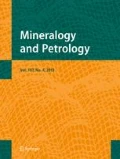Abstract
Monchetundraite, Pd2NiTe2 is a new mineral discovered in the the Monchetundra layered intrusion, Kola Peninsula, Russia. It forms euhedral grains (up to about 20 μm) intergrown with kotulskite and pentlandite. Monchetundraite is brittle and has a metallic lustre. In plane-polarized light, monchetundraite is white to creamy pinkish white, strongly pleochroic and strongly anisotropic on prismatic sections with rotations tints of pale blue, orange and olive green; it exhibits no internal reflections. Reflectance values (R1 nd R2) of monchetundraite in air are 44.3% and 45.8% at 470 nm; 48.7% and 50.7% at 546 nm; 51.4% and 53.7% at 589 nm, and 55.6% and 57.5% at 650 nm wavelength. Five electron probe micro-analyser (EPMA) measurements of monchetundraite give a mean composition of Pd 40.04 wt%, Cu 0.72 wt%, Fe 0.27 wt%, Ni 10.58 wt%, S 0.64 wt%, Te 48.20 wt%, total 100.07 wt%, which corresponds to the empirical formula (Pd1.96Cu0.06)∑2.02(Ni0.94Fe0.03)∑0.97 (Te1.97S0.04) ∑2.01 based on a total of 5 atoms. Means of eleven EPMA analyses on the synthetic analogue are Pd 40.85 wt%, Ni 10.78 wt%, Te 48.46 wt%, total 100.09 wt%, which corresponds to Pd2.03Ni0.97Te2.00. The mass density, calculated on the basis of the empirical formula, is 9.45 g/cm3. The mineral is orthorhombic, space group Ibam, with a 6.31111(13), b 11.2469(2) Å, c 5.16687(15) Å, V 366.75(1) Å3 and Z = 4. The crystal structure was solved and refined from the powder X-ray-diffraction data of synthetic Pd2NiTe2. Monchetundraite adopts the crystal structure of synthetic Pd2NiTe2, which was first determined by Pocha et al. (2007) and refined in this study. The strongest lines in the X-ray powder diffraction pattern of synthetic Pd2NiTe2 [d in Å (I) (hkl)] are: 2.8117 (100) (040), 2.6190 (33) (211), 2.5835 (32) (002), 2.3000 (41) (141), 2.1874 (39) (231), 2.1189 (22) (150), 2.0993 (22) (240), 1.9024 (52) (042), 1.8411 (26) (321), 1.3263 (32) (181). The mineral is named for the locality, the Monchetundra intrusion, Kola Peninsula, Russia.







Similar content being viewed by others
References
Amelin YV, Heaman LM, Semenov VS (1995) U-Pb geochronology of layered mafic intrusions in the eastern Baltic shield - implications for the timing and duration of Paleoproterozoic continental rifting. Precambrian Res 75:31–46
Bayanova TB, Nerovich LI, Mitrofanov FP, Zhavkov VA, Serov PA (2010) The Monchetundra basic massif of the Kola region: new geological and isotope Geochronological data. Dokl Earth Sci 431:288–293
Bruker AXS (2014) Topas 5, computing program. Bruker AXS Gmbh, Karlrsuhe
Chashchin VV, Petrov SV, Drogobuzhskaya SV (2018) Loypishnyun low-sulfide Pt–Pd deposit of the Monchetundra basic massif, Kola peninsula, Russia. Geol Ore Depos 60:418–448
Dubost V, Balić-Žunić T, Makovicky E (2007) The crystal structure of Ni9.54Pd7.46S15. Can Mineral 45:847–855
Groeneveld Meijer WOJ (1955) Synthesis, structures, and properties of platinum metal tellurides. Am Mineral 40:646–657
Grokhovskaya TL, Bakaev GF, Sholokhnev VV, Lapina MI, Muravitskaya GN (2003) The PGE ore mineralization in the Monchegorsk igneous layered complex (Kola peninsula, Russia). Geol Ore Depos 45:287–309
Grokhovskaya TL, Lapina MI, Mokhov AV (2009) Assemblages and genesis of platinum-group minerals in low-sulfide ores of the Monchetundra deposit, Kola peninsula, Russia. Geol Ore Depos 51:467–485
Grokhovskaya T, Karimova O, Vymazalová A, Laufek F, Chareev D, Kovalchuk EV, Magazina LO, Rassulov VA (2019) Nipalarsite, Ni8Pd3As4, a new platinum-group mineral from the Monchetundra intrusion, Kola peninsula, Russia. Mineral Mag 83:837–845
Kikuchi S, Wakeshima M, Hinatsu Y (2009) Electrical properties of ternary metal-rich telluride Pd2NiTe2. J Ceram Soc Japan 117:27–31
Mitrofanov FP, Smol’kin VF (2004) Layered intrusions of the Monchegorsk ore district: petrology, ore mineralization, isotopes, and deep structure. Kola Science Center, Russ Acad Sci, Apatity, 177 pp [in Russian]
Pocha R, Lohnert C, Johrendt D (2007) The metal-rich palladium chalcogenides Pd2MCh2 (M=Fe, Co, Ni; Ch=Se, Te): Crystal structure and topology of the electron density. J Solid State Chem 180:191–197
Sharkov EV (2006) Formation of layered intrusions and their ore mineraization. Moscow, Scientific World, 366 pp; [in Russian]
Strunz H, Nickel EH (2001) Strunz mineralogical tables. E. Schweizerbartsche Verlagsbuchhandlung, Stuttgart, Germany, 870 pp
Taylor A (1950) Lattice parameters of binary nickel-cobalt alloys. J Inst Met 77:585–594
Vymazalová A, Laufek F, Grokhovskaya TL, Stanley CJ (2019) Monchetundraite, IMA 2019-020. CNMNC newsletter no. 50; mineral Mag 83. https://doi.org/10.1180/mgm.2019.46
Acknowledgements
The authors acknowledge Ritsumo Miyawaki, Chairman of the Commission on New Minerals, Nomenclature and Classification of the International Mineralogical Association, and its members for helpful comments on the submitted data. The authors are grateful to Ondřej Pour (Czech Geological Survey) for EBSD measurements, and Elena Kovalchuk (Institute of Ore Deposits, Petrography, Mineralogy and Geochemistry, Russian Academy of Sciences) and Zuzana Korbelová (Institute of Geology, Czech Academy of Sciences) for carrying out the EPMA analyses. Constructive reviews by Andrei Y. Barkov and Louis J. Cabri as well as editorial comments by associate editor Luca Bindi and chief editor Lutz Nasdala are sincerely appreciated. This work was supported by the Grant Agency of the Czech Republic (project 18-15390S) and by the Russian Academy of Sciences, Program of Fundamental Research. C.J. Stanley acknowledges Natural Environment Research Council grant NE/M010848/1 Tellurium and selenium cycling and supply.
Author information
Authors and Affiliations
Corresponding author
Additional information
Editorial handling: L. Bindi
Publisher’s note
Springer Nature remains neutral with regard to jurisdictional claims in published maps and institutional affiliations.
Rights and permissions
About this article
Cite this article
Vymazalová, A., Laufek, F., Grokhovskaya, T.L. et al. Monchetundraite, Pd2NiTe2, a new mineral from the Monchetundra layered intrusion, Kola Peninsula, Russia. Miner Petrol 114, 263–271 (2020). https://doi.org/10.1007/s00710-020-00698-9
Received:
Accepted:
Published:
Issue Date:
DOI: https://doi.org/10.1007/s00710-020-00698-9




